Biogas and Biomethane Production and Usage: Technology Development, Advantages and Challenges in Europe
Abstract
:1. Introduction
2. Methods
3. Biogas Production
3.1. Biogas Composition
3.2. The Biogas Production: From Substrate to Biomethane
3.3. Using Technologies in Biogas and Biomethane Production
3.3.1. Anaerobic Digestion
3.3.2. Thermal and Hydrothermal Gasification
3.3.3. Process Pretreatments
3.4. Biogas Puification and Upgrading
3.5. Biogas Usage
4. Biogas Production in Europe
5. Discussion
6. Conclusions
Author Contributions
Funding
Institutional Review Board Statement
Informed Consent Statement
Data Availability Statement
Conflicts of Interest
References
- European Commission (EC). The European Green Deal; European Commission: Brussels, Belgium, 2019.
- European Comission (EC). Fit for 55’: Delivering the EU’s 2030 Climate Target on the Way to Climate Neutrality; European Commission: Brussels, Belgium, 2019. Available online: https://www.eesc.europa.eu/en/our-work/opinions-information-reports/opinions/fit-55-delivering-eus-2030-climate-target-way-climate-neutrality (accessed on 15 March 2022).
- Catuti, M.; Egenhofer, C.; Elkerbout, M. The Future of Gas in Europe: Review of Recent Studies on the Future of Gas; CEPS Research Report No. 2019/03; CEPS Energy Climate House: Brussels, Belgium, 2019. [Google Scholar]
- European Comission. Directive (EU) 2018/2001 of the European Parliament and of the Council of 11 December 2018 on the Promotion of the Use of Energy from Renewable Sources (Text with EEA Relevance). 2018; p. 328. Available online: https://eur-lex.europa.eu/legal-content/EN/TXT/?uri=uriserv:OJ.L_.2018.328.01.0082.01.ENG (accessed on 12 April 2022).
- Panoutsou, C.; Germer, S.; Karka, P.; Papadokostantakis, S.; Kroyan, Y.; Wojcieszyk, M.; Maniatis, K.; Marchand, P.; Landalv, I. Advanced biofuels to decarbonise European transport by 2030: Markets, challenges, and policies that impact their successful market uptake. Energy Strategy Rev. 2021, 34, 100633. [Google Scholar] [CrossRef]
- Directive 98/70/EC of the European Parliament and of the Council of 13 October 1998 Relating to the Quality of Petrol and Diesel Fuels and Amending Council Directive 93/12/EEC. Available online: https://eur-lex.europa.eu/legal-content/EN/ALL/?uri=CELEX%3A31998L0070 (accessed on 23 March 2022).
- Directive 2009/28/EC of the European Parliament and of the Council of 23 April 2009 on the Promotion of the Use of Energy from Renewable Sources and Amending and Subsequently Repealing Directives 2001/77/EC and 2003/30/EC. Available online: https://eur-lex.europa.eu/legal-content/EN/ALL/?uri=CELEX%3A32009L0028 (accessed on 23 March 2022).
- ePURE. 2022 National Biofuels Policies; ePURE: Brussels, Belgium, 2022; Available online: https://www.epure.org/news/updated-for-2022-national-biofuels-policies-across-the-eu/ (accessed on 23 March 2022.).
- European Commission (EC). Communication on an EU Strategy to Reduce Methane Emissions; European Comission: Brussels, Belgium, 2020. Available online: https://eur-lex.europa.eu/legal-content/EN/TXT/?uri=CELEX%3A52020DC0663 (accessed on 15 March 2022).
- European Commission (EC). Powering a Climate-Neutral Economy: An EU Strategy for Energy System Integration; European Comission: Brussels, Belgium, 2020. Available online: https://eur-lex.europa.eu/legal-content/EN/ALL/?uri=COM:2020:299:FIN (accessed on 23 March 2022).
- European Commission (EC). A Farm to Fork Strategy for a Fair, Healthy and Environmentally-Friendly food System; EC: Brussels, Belgium, 2020. Available online: https://eur-lex.europa.eu/legal-content/EN/TXT/?uri=CELEX%3A52020DC0381 (accessed on 23 March 2022).
- Gustafsson, M.; Anderberg, S. Biogas policies and production development in Europe: A comparative analysis of eight countries. Biofuels 2022, 1–14. [Google Scholar] [CrossRef]
- Stern, J. Narratives for Natural Gas in Decarbonising European Energy Markets; The Oxford Institute for Energy Studies: Oxford, UK, 2019; Available online: https://www.oxfordenergy.org/publications/narratives-natural-gas-decarbonising-european-energy-markets/ (accessed on 23 March 2022).
- Korbag, I.; Omer, S.M.S.; Boghazala, H.; Abusasiyah, M.A.A. Recent Advances of Biogas Production and Future Perspective. In Biogas—Recent Advances and Integrated Approaches; Abomohra, A.E., Elsayed, M., Qin, Z., Ji, H., Liu, Z., Eds.; IntechOpen: London, UK, 2020. [Google Scholar]
- Abanades, S.; Abbaspour, H.; Ahmadi, A.; Das, B.; Ehyaei, M.A.; Esmaeilion, F.; Assad, M.E.H.; Hajilounezhad, T.; Jamali, D.H.; Hmida, A.; et al. A critical review of biogas production and usage with legislations framework across the globe. Int. J. Environ. Sci. Technol. 2021, 19, 3377–3400. [Google Scholar] [CrossRef] [PubMed]
- European Biogas Association (EBA). EBA Statistical Report 2021; EBA: Brussels, Belgium, 2022; Available online: https://www.europeanbiogas.eu/eba-statistical-report-2021/ (accessed on 23 March 2022).
- Fang, Z. (Ed.) Liquid, Gaseous and Solid Biofuels—Conversion Techniques; IntechOpen: London, UK, 2013. [Google Scholar]
- Olugbade, T.; Ojo, O.; Mohammed, T. Influence of Binders on Combustion Properties of Biomass Briquettes: A Recent Review. BioEnergy Res. 2019, 12, 241–259. [Google Scholar] [CrossRef]
- Olugbade, T.O.; Ojo, O.T. Biomass Torrefaction for the Production of High-Grade Solid Biofuels: A Review. BioEnergy Res. 2020, 13, 999–1015. [Google Scholar] [CrossRef]
- Olugbade, T.O.; Ojo, O.T. Binderless briquetting technology for lignite briquettes: A review. Energy Ecol. Environ. 2021, 6, 69–79. [Google Scholar] [CrossRef]
- Zhu, P.; Abdelaziz, O.; Hulteberg, C.P.; Riisager, A. New synthetic approaches to biofuels from lignocellulosic biomass. Curr. Opin. Green Sustain. Chem. 2020, 21, 16–21. [Google Scholar] [CrossRef]
- Awogbemi, O.; Von Kallon, D.V.; Onuh, E.I.; Aigbodion, V.S. An Overview of the Classification, Production and Utilization of Biofuels for Internal Combustion Engine Applications. Energies 2021, 14, 5687. [Google Scholar] [CrossRef]
- Mahapatra, S.; Kumar, D.; Singh, B.; Sachan, P.K. Biofuels and their sources of production: A review on cleaner sustainable alternative against conventional fuel, in the framework of the food and energy nexus. Energy Nexus 2021, 4, 100036. [Google Scholar] [CrossRef]
- Malode, S.J.; Prabhu, K.K.; Mascarenhas, R.J.; Shetti, N.P.; Aminabhavi, T.M. Recent advances and viability in biofuel production. Energy Convers. Manag. 2021, 10, 100070. [Google Scholar] [CrossRef]
- Mizik, T.; Gyarmati, G. Economic and Sustainability of Biodiesel Production—A Systematic Literature Review. Clean Technol. 2021, 3, 2. [Google Scholar] [CrossRef]
- Zabermawi, N.; Alsulaimany, F.A.; El-Saadony, M.T.; El-Tarabily, K.A. New eco-friendly trends to produce biofuel and bioenergy from microorganisms: An updated review. Saudi J. Biol. Sci. 2022; in press. [Google Scholar] [CrossRef]
- Oke, D.; Dunn, J.B.; Troy, R.; Hawkins, T.R. The contribution of biomass and waste resources to decarbonizing transportation and related energy and environmental effects. Sustain. Energy Fuels 2022, 6, 721–735. [Google Scholar] [CrossRef]
- Jiang, B.; Zhang, Y.; Guo, T.; Zhao, H.; Jin, Y. Structural Characterization of Lignin and Lignin-Carbohydrate Complex (LCC) from Ginkgo Shells (Ginkgo biloba L.) by Comprehensive NMR Spectroscopy. Polymers 2018, 10, 736. [Google Scholar] [CrossRef] [PubMed] [Green Version]
- Hernández-Beltrán, J.U.; Lira, I.O.H.-D.; Cruz-Santos, M.M.; Saucedo-Luevanos, A.; Hernández-Terán, F.; Balagurusamy, N. Insight into Pretreatment Methods of Lignocellulosic Biomass to Increase Biogas Yield: Current State, Challenges, and Opportunities. Appl. Sci. 2019, 9, 3721. [Google Scholar] [CrossRef] [Green Version]
- Nwokolo, N.; Mukumba, P.; Obileke, K.; Eneme, M. Waste to energy: A focus on the impact of substrate type in biogas production. Processes 2020, 8, 1224. [Google Scholar] [CrossRef]
- International Energy Agency (IEA). Outlook for Biogas and Biomethane: Prospects for Organic Growth; IEA: Paris, France, 2022. Available online: https://iea.blob.core.windows.net/assets/03aeb10c-c38c-4d10-bcec-de92e9ab815f/Outlook_for_biogas_and_biomethane.pdf (accessed on 15 March 2022).
- Scarlat, N.; Dallemand, J.-F.; Fahl, F. Biogas: Developments and perspectives in Europe. Renew. Energy 2018, 129, 457–472. [Google Scholar] [CrossRef]
- Saadabadi, S.A.; Thattai, A.T.; Fan, L.; Lindeboom, R.E.; Spanjers, H.; Aravind, P. Solid Oxide Fuel Cells fuelled with biogas: Potential and constraints. Renew. Energy 2019, 134, 194–214. [Google Scholar] [CrossRef]
- Stern, J. The role of gases in the European energy transition. Russ. J. Econ. 2020, 6, 390–405. [Google Scholar] [CrossRef]
- Jafri, Y.; Waldheim, L.; Lundgren, J. Emerging Gasification Technologies for Waste & Biomass; IEA Bioenergy: Dublin, Ireland, 2020; Available online: https://www.ieabioenergy.com/wp-content/uploads/2021/02/Emerging-Gasification-Technologies_final.pdf (accessed on 23 March 2022).
- European Biogas Association (EBA). Market State and Trends in Renewable and Low-Carbon Gases in Europe. EBA: Brussels, Belgium, 2020; Available online: https://www.europeanbiogas.eu/market-state-and-trends-in-renewable-and-low-carbon-gases-in-europe/ (accessed on 23 March 2022).
- Yang, L.; Ge, X.; Wan, C.; Yu, F.; Li, Y. Progress and perspectives in converting biogas to transportation fuels. Renew. Sustain. Energy Rev. 2014, 40, 1133–1152. [Google Scholar] [CrossRef]
- Damyanova, S.; Beschkov, V. Biogas as a source of energy and chemicals. In Biorefnery Concepts; Beschkov, V., Ed.; IntechOpen: London, UK, 2019. [Google Scholar]
- Persson, M.; Jonsson, O.; Wellinger, A. Biogas Upgrading to Vehicle Fuel Standards and grid Injection; IEA Bioenergy: Dublin, Ireland, 2006; p. 32. Available online: https://www.ieabioenergy.com/wp-content/uploads/2007/12/upgrading_report_final.pdf: (accessed on 15 March 2022).
- Moya, C.; Santiago, R.; Hospital-Benito, D.; Lemus, J.; Palomar, J. Design of biogas upgrading processes based on ionic liquids. Chem. Eng. J. 2021, 428, 132103. [Google Scholar] [CrossRef]
- Thrän, D.; Persson, T.; Daniel-Gromke, J.; Ponitka, J.; Seiffert, M.; Baldwin, J.; Kranzl, L.; Schipfer, F.; Matzenberger, J.; Devriendt, N.; et al. Biomethane Status and Factors Affecting Market Development and Trade; IEA Bioenergy: Dublin, Ireland, 2014; Available online: https://publik.tuwien.ac.at/files/PubDat_234171.pdf (accessed on 23 March 2022).
- Energy Institute Hrvoje Požar (EIHP). Available online: http://www.eihp.hr/wp-content/uploads/2018/03/BiogasAction-ViroExpo-prezentacija_EIHP.pdf (accessed on 23 March 2022).
- Kovačić, Đ. Development of the Lignocellulose Pretreatment by Heat and Electric Field for Biogas Production by Anaerobic Co-digestion with Cow Manure. Ph.D. Thesis, University of Osijek, Osijek, Croatia, 2017. [Google Scholar]
- Garcia, N.H.; Mattioli, A.; Gil, A.; Frison, N.; Battista, F.; Bolzonella, D. Evaluation of the methane potential of different agricultural and food processing substrates for improved biogas production in rural areas. Renew. Sustain. Energy Rev. 2019, 112, 1–10. [Google Scholar] [CrossRef]
- Pereira, A.J.M.; Elvira, P.S.I.; Oneto, S.J.; Cruz, D.L.R.; Portela, J.R.; Nebot, E. Enhancement of methane production in mesophilic anaerobic digestion of secondary sewage sludge by advanced thermal hydrolysis pretreatment. Water Res. 2015, 71, 330–340. [Google Scholar] [CrossRef] [PubMed]
- Farida, H.; Lee Chang, Y.; Hirotsugu, K.; Abdul, A.H.; Yoichi, A.; Takeshi, Y.; Hiroyuki, D. Treatment of sewage sludge using anaerobic digestion in Malaysia: Current state and challenges. Front. Energy Res. 2019, 7, 19. [Google Scholar]
- Kaur, G.; Luo, L.; Chen, G.; Wong, J.W. Integrated food waste and sewage treatment—A better approach than conventional food waste-sludge co-digestion for higher energy recovery via anaerobic digestion. Bioresour. Technol. 2019, 289, 121698. [Google Scholar] [CrossRef]
- Song, Y.-J.; Oh, K.-S.; Lee, B.; Pak, D.-W.; Cha, J.-H.; Park, J.-G. Characteristics of Biogas Production from Organic Wastes Mixed at Optimal Ratios in an Anaerobic Co-Digestion Reactor. Energies 2021, 14, 6812. [Google Scholar] [CrossRef]
- McCabe, B.K.; Schmidt, T. Integrated Biogas Systems: Local Applications of Anaerobic Digestion towards Integrated Sustainable Solutions; Technical Report; IEA Bioenergy: Dublin, Ireland, 2008; Available online: https://www.ieabioenergy.com/wp-content/uploads/2018/06/Integrated-biogas-systems_WEB.pdf (accessed on 15 March 2022).
- Jain, S. Global Potential of Biogas; World Biogas Association: London, UK, 2019; Available online: https://www.worldbiogasassociation.org/wp-content/uploads/2019/09/WBA-globalreport-56ppa4_digital-Sept-2019.pdf (accessed on 18 March 2022).
- Al Seadi, T.; Rutz, D.; Prassl, H.; Kottner, M.; Finsterwalder, T.; Volk, S.; Janssen, R. Handbook of Biogas; University of Southern Denmark: Esbjerg, Denmark, 2008. [Google Scholar]
- Weiland, P. Biogas production: Current state and perspectives. Appl. Microbiol. Biotechnol. 2010, 85, 849–860. [Google Scholar] [CrossRef]
- Sahota, S.; Shah, G.; Ghosh, P.; Kapoor, R.; Sengupta, S.; Singh, P.; Vijay, V.; Sahay, A.; Vijay, V.K.; Thakur, I.S. Review of trends in biogas upgradation technologies and future perspectives. Bioresour. Technol. Rep. 2018, 1, 79–88. [Google Scholar] [CrossRef]
- Sriramajayam, S.; Ramesh, D. Studies on biomethanation of kitchen wastes. Trends Biosci. 2006, 8/16, 4332–4335. [Google Scholar]
- Banerjee, S.; Prasad, N.; Selvaraju, S. Reactor Design for Biogas Production-A Short Review. J. Energy Power Technol. 2021, 4, 14. [Google Scholar] [CrossRef]
- Ryue, J.; Lin, L.; Kakar, F.L.; El beshbishy, E.; Al-Mamun, A.; Dhar, B.R. A critical review of conventional and emerging methods for improving process stability in thermophilic anaerobic digestion. Energy Sustain. Dev. 2020, 54, 72–84. [Google Scholar] [CrossRef]
- Kumar RNeerudu, U.K.; Ragini Gothalwal, R.; Mohapatra, S.; Deshpande, P.K.; Mukunda Vani, M.; Merugu, R. Bioprocess Parameters for Thermophilic and Mesophilic Biogas Production: Recent Trends and Challenges. In Bioenergy Research: Basic and Advanced Concepts. Clean Energy Production Technologies; Srivastava, M., Srivastava, N., Singh, R., Eds.; Springer: Singapore, 2021; pp. 225–256. [Google Scholar]
- Anukam, A.; Berghel, J. Biomass Pretreatment and Characterization: A Review. In Biotechnological Applications of Biomass; Basso, T.P., Basso, T.O., Basso, L.C., Eds.; IntechOpen: London, UK, 2020. [Google Scholar]
- Mao, C.; Feng, Y.; Wang, X.; Ren, G. Review on research achievements of biogas from anaerobic digestion. Renew. Sustain. Energy Rev. 2015, 45, 540–555. [Google Scholar] [CrossRef]
- Yu, L.; Ma, J.; Frear, C.; Zaher, U.; Chen, S. Two-Stage Anaerobic Digestion Systems Wherein One of the Stages Comprises a two-Phase System. United States Patent Application Publication, 2017. Available online: https://patents.google.com/patent/US20130309740A1/en (accessed on 23 March 2022).
- Hamad, M.A.F.; Radwan, A.M.; Amin, A. Review of Biomass Thermal Gasification. In Biomass Volume Estimation and Valorization for Energy. InTech: London, UK, 2017. [Google Scholar]
- Karuppiah, T.; Azariah, V.E. Biomass Pretreatment for Enhancement of Biogas Production. In Anaerobic Digestion; Banu, J.R., Ed.; IntechOpen: London, UK, 2019. [Google Scholar]
- Wagner, A.O.; Lackner, N.; Mutschlechner, M.; Prem, E.M.; Markt, R.; Illmer, P. Biological pretreatment strategies for second-generation lignocellulosic resources to enhance biogas roduction. Energies 2018, 11, 1797. [Google Scholar] [CrossRef] [PubMed] [Green Version]
- Zieliński, M.; Kisielewska, M.; Dudek, M.; Rusanowska, P.; Nowicka, A.; Krzemieniewski, M.; Kazimierowicz, J.; Dębowski, M. Comparison of microwave thermohydrolysis and liquid hot water pretreatment of energy crop Sida hermaph-rodita for enhanced methane production. Biomass Bioenergy 2019, 128, 105324. [Google Scholar] [CrossRef]
- Marta, K.; Paulina, R.; Magda, D.; Nowicka, A.; Krzywik, A.; Dębowski, M.; Kazimierowicz, J.; Zieliński, M. Evaluation of ultrasound pretreatment for enhanced anaerobic digestion of Sida hermaphrodita. Bioenerg. Res. 2020, 13, 824–832. [Google Scholar] [CrossRef] [Green Version]
- Orlando, M.-Q.; Borja, V.-M. Pretreatment of animal manure biomass to improve biogas production: A review. Energies 2020, 13, 3573. [Google Scholar] [CrossRef]
- Achinas, S.; Achinas, V.; Euverink, G.J.W. A technological overview of biogas production from biowaste. Eng. J. 2017, 3, 230–299. [Google Scholar] [CrossRef]
- Baruah, J.; Nath Bikash Kar, N.B.; Ritika, S.; Sachin, K.; Chandra, D.R.; Chandra, B.D.; Eeshan, K. Recent trends in the pretreatment of lignocellulosic biomass for value-added products. Front. Energy Res. 2018, 6, 141. [Google Scholar] [CrossRef]
- Bharathiraja, B.; Jayamuthunagai, J.; Chakravarthy, M.; Kumar, R.P. Bioprocess of biofuels for Green and Clean Environment. In Bioprocess Engineering for a Green Environment, 1st ed.; Sivasubramanian, V., Ed.; CRC Press: Boca Raton, FL, USA, 2018; p. 13. [Google Scholar]
- Capolupo, L.; Faraco, V. Green methods of lignocellulose pretreatment for biorefinery development. Appl. Microbiol. Biotechnol. 2016, 100, 9451–9467. [Google Scholar] [CrossRef] [Green Version]
- Yu, H.; Zhang, F.; Li, L.; Wang, H.; Sun, Y.; Jiang, E.; Xu, X. Boosting levoglucosan and furfural production from corn stalks pyrolysis via electro-assisted seawater pretreatment. Bioresour. Technol. 2021, 346, 126478. [Google Scholar] [CrossRef]
- Panigrahi, S.; Sharma, H.B.; Tiwari, B.R.; Krishna, N.V.; Ghangrekar, M.; Dubey, B.K. Insight into understanding the performance of electrochemical pretreatment on improving anaerobic biodegradability of yard waste. Renew. Energy 2021, 180, 1166–1178. [Google Scholar] [CrossRef]
- Kasinath, A.; Fudala-Ksiazek, S.; Szopinska, M.; Bylinski, H.; Artichowicz, W.; Remiszewska-Skwarek, A.; Luczkiewicz, A. Biomass in biogas production: Pretreatment and codigestion. Renew. Sustain. Energy Rev. 2021, 150, 111509. [Google Scholar] [CrossRef]
- Abraham, A.; Mathew, A.K.; Park, H.; Choi, O.; Sindhu, R.; Parameswaran, B.; Pandey, A.; Park, J.H.; Sang, B.I. Pre-treatment strategies for enhanced biogas production from lignocellulosic biomass. Bioresour. Technol. 2020, 301, 122725. [Google Scholar] [CrossRef] [PubMed]
- Rodriguez, C.; Alaswad, A.; Benyounis, K.Y.; Olabi, A.G. Pretreatment techniques used in biogas production from grass. Renew. Sustain. Energy Rev. 2017, 68, 1193–1204. [Google Scholar] [CrossRef] [Green Version]
- Wu, Y.N.; Mattsson, M.; Ding, M.W.; Wu, M.T.; Mei, J.; Shen, Y.L. Effects of Different Pretreatments on Improving Biogas Production of Macroalgae Fucus vesiculosus and Fucus serratus in Baltic Sea. Energy Fuels 2019, 33, 2278–2284. [Google Scholar] [CrossRef]
- Ryckebosch, E.; Drouillon, M.; Vervaeren, H. Techniques for transformation of biogas to biomethane. Biomass Bioenergy 2011, 35, 1633–1645. [Google Scholar] [CrossRef]
- Bauer, F.; Persson, T.; Hulteberg, C.; Tamm, D. Biogas upgrading—Technology overview, comparison and perspectives for the future. Biofuels Bioprod. Biorefin. 2013, 7, 499–511. [Google Scholar] [CrossRef]
- Bora, D.; Barbora, L.; Borah, A.J.; Mahanta, P. A Comparative assessment of biogas upgradation techniques and its utilization as an alternative fuel in internal combustion engines. In Alternative Fuels and Advanced Combustion Techniques as Sustainable Solutions for Internal Combustion Engines; Singh, A.P., Kumar, D., Agarwal, A.K., Eds.; Springer: Singapore, 2021; pp. 11–95. [Google Scholar]
- Sun, Q.; Li, H.; Yan, J.; Liu, L.; Yu, Z.; Yu, X. Selection of appropriate biogas upgrading technology—A review of biogas cleaning, upgrading and utilisation. Renew. Sustain. Energy Rev. 2015, 51, 521–532. [Google Scholar] [CrossRef]
- Rodero, M.R.; Angeles, R.; Marin, D.; Diaz, I.; Colzi, A.; Posadas, E.; Lebrero, R.; Munoz, R. Biogas Purification and Upgrading Technologies. In Biogas: Fundamentals, Process, and Operation; Tabatabaei, M., Ghanavati, H., Eds.; Springer International Publishing: Cham, Switzerland, 2018. [Google Scholar]
- Adnan, A.I.; Ong, M.Y.; Nomanbhay, S.; Chew, K.W.; Show, P.L. Technologies for Biogas Upgrading to Biomethane: A Review. Bioengineering 2019, 6, 92. [Google Scholar] [CrossRef] [PubMed] [Green Version]
- Niesner, J.; Jeca, D.; Stehlik, P. Biogas upgrading technologies: State of art review in European region. Chem. Eng. Trans. 2013, 35, 517–522. [Google Scholar]
- De Oliveira, L.H.; Meneguin, J.G.; Pereira, M.V.; Nascimento, J.F.D.; Arroyo, P. Adsorption of hydrogen sulfide, carbon dioxide, methane, and their mixtures on activated carbon. Chem. Eng. Commun. 2019, 206, 1533–1553. [Google Scholar] [CrossRef]
- Lee, W.Y.; Park, S.Y.; Lee, K.B.; Nam, S.C. Simultaneous removal of CO2 and H2S from biogas by blending amine absorbents: A performance comparison Study. Energy Fuels 2020, 34, 1992–2000. [Google Scholar] [CrossRef]
- Ramli, A.; Ahmed, S.; Yusup, S. Adsorption behavior of Si-MCM-41 for CO2: Effect of pressure and temperature on adsorption. Chem. Eng. Trans. 2014, 39, 271–276. [Google Scholar]
- He, X.; Zhu, J.; Wang, H.; Zhou, M.; Zhang, S. Surface Functionalization of Activated Carbon with Phosphonium Ionic Liquid for CO2 Adsorption. Coatings 2019, 9, 590. [Google Scholar] [CrossRef] [Green Version]
- Ziobrowski, Z.; Rotkegel, A. Comparison of CO2 Separation Efficiency from Flue Gases Based on Commonly Used Methods and Materials. Materials 2022, 15, 460. [Google Scholar] [CrossRef]
- Ou, H.; Fang, M.; Chou, M.; Chang, H.; Shiao, T. Long-term evaluation of activated carbon as an adsorbent for biogas desulfurization. J. Air Waste Manag. Assoc. 2020, 70, 641–648. [Google Scholar] [CrossRef]
- Sawalha, H.; Maghalseh, M.; Qutaina, J.; Junaidi, K.; Rene, E.R. Removal of hydrogen sulfide from biogas using activated carbon synthesized from different locally available biomass wastes—A case study from Palestine. Bioengineered 2020, 11, 607–618. [Google Scholar] [CrossRef]
- Narang, K.; Akhtar, F. Freeze Granulated Zeolites X and A for Biogas Upgrading. Molecules 2020, 25, 1378. [Google Scholar] [CrossRef] [Green Version]
- Raganati, F.; Misccio, F.; Ammendola, P. Adsorption of carbon dioxide for post-combustion capture: A review. Energy Fuels 2021, 35, 12845–12868. [Google Scholar] [CrossRef]
- Bhatt, P.M.; Belmabkhout, Y.; Assen, A.H.; Weseliński, Ł.J.; Jiang, H.; Cadiau, A.; Xue, D.X.; Eddaoudi, M. Isoreticular rare Earth fcu-MOFs for the selective removal of H2S from CO2 containing gases. Chem. Eng. J. 2017, 324, 392–396. [Google Scholar] [CrossRef] [Green Version]
- Yu, J.; Xie, L.H.; Li, J.R.; Ma, Y.; Seminario, J.M.; Balbuena, P.B. CO2 Capture and separations using MOFs: Computational and experimental studies. Chem. Rev. 2017, 117, 674–9754. [Google Scholar] [CrossRef] [PubMed]
- Taddei, M.; Petit, C. Engineering metal–organic frameworks for adsorption-based gas separations: From process to atomic scale. Mol. Syst. Des. Eng. 2021, 6, 841–875. [Google Scholar] [CrossRef]
- Alonso, A.; Vico, J.M.; Markeb, A.A.; Busquets-Fité, M.; Komilis, D.; Puntes, V.; Sánchez, A.; Font, X. Critical review of existing nanomaterial adsorbents to capture carbon dioxide and methane. Sci. Total Environ. 2017, 595, 51–62. [Google Scholar] [CrossRef] [PubMed] [Green Version]
- Sanaeepur, H.; Amooghin, A.E.; Bandehali, S.; Moghadassi, A.; Matsuura, T.; Van der Bruggen, B. Polyimides in membrane gas separation: Monomer’s molecular design and structural engineering. Prog. Polym. Sci. 2019, 91, 80–125. [Google Scholar] [CrossRef]
- Norahim, N.; Yaisanga, P.; Faungnawakij, K.; Charinpanitkul, T.; Klaysom, C. Recent Membrane Developments for CO2 Separation and Capture. Chem. Eng. Technol. 2018, 41, 211–223. [Google Scholar] [CrossRef]
- Galizia, M.; Chi, W.S.; Smith, Z.P.; Merkel, T.C.; Baker, R.W.; Freeman, B.D. 50th Anniversary Perspective: Polymers and Mixed Matrix Membranes for Gas and Vapor Separation: A Review and Prospective Opportunities. Macromolecules 2017, 50, 7809–7843. [Google Scholar] [CrossRef]
- Baccanelli, M.; Langè, S.; Rocco, M.V.; Pellegrini, L.A.; Colombo, E. Low temperature techniques for natural gas purification and LNG production: An energy and exergy analysis. Appl. Energy 2016, 180, 546–559. [Google Scholar] [CrossRef]
- Font-Palma, C.; Cann, D.; Udemu, C. Review of cryogenic carbon capture innovations and their potential applications. C 2021, 7, 58. [Google Scholar] [CrossRef]
- Babar, M.; Bustam, M.A.; Ali, A.; Maulud, A.S.; Shafiq, U.; Mukhtar, A.; Shah, S.N.; Maqsood, K.; Mellon, N.; Shariff, A.M. Thermodynamic data for cryogenic carbon dioxide capture from natural gas: A review. Cryogenics 2019, 102, 85–104. [Google Scholar] [CrossRef]
- Kapoor, R.; Ghosh, P.; Kumar, M.; Vijay, V.K. Evaluation of biogas upgrading technologies and future perspectives: A review. Environ. Sci. Pollut. Res. 2019, 26, 11631–11661. [Google Scholar] [CrossRef]
- Edison, S.M. Bio-methane generation from organic waste: A review. In Proceedings of the World Congress on Engineering and Computer Science (WCECS), San Francisco, CA, USA, 22–24 October 2014. [Google Scholar]
- Bond, T.; Templeton, M. History and future of domestic biogas plants in the developing world. Energy Sustain. Dev. 2011, 15, 347–354. [Google Scholar] [CrossRef]
- Aurelia Figueroa, A.; Boshell, F.; van Velzen, L.; Anisie, A. Biogas for Domestic Cooking Technology Brief; International Renewable Energy Agency: Abu Dhabi, United Arab Emirates, 2017; Available online: https://www.irena.org/-/media/Files/IRENA/Agency/Publication/2017/Dec/IRENA_Biogas_for_domestic_cooking_2017.pdf (accessed on 12 April 2022).
- Ali, M.Y.; Hassan, M.; Rahman, M.A.; Kafy, A.A.; Ara, I.; Javed, A.; Rahman, M.R. Life cycle energy and cost analysis of small scale biogas plant and solar PV system in rural areas of Bangladesh. Energy Procedia 2019, 160, 277–284. [Google Scholar] [CrossRef]
- Pilloni, M.; Hamed, T.A. Small-Size Biogas Technology Applications for Rural Areas in the Context of Developing Countries. In Anaerobic Digestion in Built Environments; Sikora, A., Ed.; IntechOpen: London, UK, 2021. [Google Scholar]
- Sawyerr, N.; Trois, C.; Workneh, T.S.; Oyebode, O.; Babatunde, O.M. Design of a household biogas digester using co-digested cassava, vegetable and fruit waste. Energy Rep. 2020, 6, 1476–1482. [Google Scholar] [CrossRef]
- Grim, J.; Nilsson, D.; Hansson, P.-A.; Nordberg, Å. Demand-Orientated Power Production from Biogas: Modeling and Simulations under Swedish Conditions. Energy Fuels 2015, 29, 4066–4075. [Google Scholar] [CrossRef] [Green Version]
- Fan, W.; Huang, L.; Tan, Z.; Xue, F.; De, G.; Song, X.; Cong, B. Multi-objective Optimal Model of Rural Multi-energy Complementary System with Biogas Cogeneration and Electric Vehicle Considering Carbon Emission and Satisfaction. Sustain. Cities Soc. 2021, 74, 103225. [Google Scholar] [CrossRef]
- Ishikawa, S.; Connell, N.O.; Lechner, R.; Hara, R.; Kita, H.; Brautsch, M. Load response of biogas CHP systems in a power grid. Renew. Energy 2021, 170, 12–26. [Google Scholar] [CrossRef]
- Yin, Y.; Chen, S.; Li, X.; Jiang, B.; Zhao, J.R.; Nong, G. Comparative analysis of different CHP systems using biogas for the cassava starch plants. Energy 2021, 232, 121028. [Google Scholar] [CrossRef]
- Shah, M.S.; Halder, P.K.; Shamsuzzaman AS, M.; Hossain, M.S.; Pal, S.K.; Sarker, E. Perspectives of biogas conversion into bio-CNG for automobile fuel in Bangladesh. J. Renew. Energy 2017, 2017, 4385295. [Google Scholar] [CrossRef] [Green Version]
- Karagöz, Y. Analysis of the impact of gasoline, biogas and biogas + hydrogen fuels on emissions and vehicle performance in the WLTC and NEDC. Int. J. Hydrogen Energy 2019, 44, 31621–31632. [Google Scholar] [CrossRef]
- de Castro, R.E.N.; Alves, R.M.B.; Nascimento, C.A.O. Assessing the sugarcane bagasse and straw as a biofuel to propel light vehicles. Sustain. Energy Fuels 2021, 5, 2563–2577. [Google Scholar] [CrossRef]
- Rosén, T.; Ödlund, L. System Perspective on Biogas Use for Transport and Electricity Production. Energies 2019, 12, 4159. [Google Scholar] [CrossRef] [Green Version]
- Shafie, S.M.; Othman, Z.; Hami, N.; Omar, S.; Nu’man, A.H.; Yusuf, N.N.A.N.; Shah, A. Biogas fed-fuel cell based electricity generation: A life cycle assessment approach. Int. J. Energy Econ. Policy 2020, 10, 498–502. [Google Scholar] [CrossRef]
- Roubík, H.; Mazancová, J. Suitability of small-scale biogas systems based on livestock manure for the rural areas of Sumatra. Environ. Dev. 2020, 33, 100505. [Google Scholar] [CrossRef]
- Putti, V.R.; Tsan, M.; Mehta, S.; Kammila, S. The State of the Global Clean and Improved Cooking Sector; Technical Paper No. 007/15; Energy Sector Management Assistance Program ESMAP; World Bank: Washington, DC, USA, 2015. [Google Scholar]
- Livestock and Poultry Environmental Learning Community (LPELC). Available online: https://lpelc.org/ (accessed on 25 March 2022).
- Frazier, S.; Hamilton, D.; Ndegwa, P.M. Anaerobic Digestion: Biogas Utilization and Cleanup. Oklahoma State University. 2017. Available online: https://extension.okstate.edu/fact-sheets/anaerobic-digestion-biogas-utilization-and-cleanup.html (accessed on 25 March 2022).
- Patterson, T.; Dinsdale, R.; Esteves, S. Review of Energy Balances and Emissions Associated with Biomass-Based Transport Fuels Relevant to the United Kingdom Context. Energy Fuels 2008, 22, 3506–3512. [Google Scholar] [CrossRef]
- Chandra, R.; Vijay, V.; Subbarao, P.; Khura, T. Performance evaluation of a constant speed IC engine on CNG, methane enriched biogas and biogas. Appl. Energy 2011, 88, 3969–3977. [Google Scholar] [CrossRef]
- Clarke, S. Vehicle Conversion to Natural Gas or Biogas; Ministry of Agriculture, Food and Rural Affairs: Ontario, CA, USA, 2012.
- Boyano, A.; Morosuk, T.; Blanco-Marigorta, A.M.; Tsatsaronis, G. Conventional and advanced exergo environmental analysis of a steam methane reforming reactor for hydrogen production. J. Clean. Prod. 2012, 20, 152–160. [Google Scholar] [CrossRef]
- Serrano-Lotina, A.; Daza, L. Influence of the operating parameters over dry reforming of methane to syngas. Int. J. Hydrogen Energy 2014, 39, 4089–4094. [Google Scholar] [CrossRef]
- Li, Y.; Yang, L. Converting Biogas to Transportation Fuels; Ohio State University Extension: Columbus, OH, USA, 2014; Available online: https://ohioline.osu.edu/factsheet/AEX-653.2 (accessed on 25 March 2022).
- Alves, H.J.; Junior, C.B.; Niklevicz, R.R.; Frigo, E.P.; Frigo, M.S.; Coimbra-Araújo, C.H. Overview of hydrogen production technologies from biogas and the applications in fuel cells. Int. J. Hydrogen Energy 2013, 38, 5215–5225. [Google Scholar] [CrossRef]
- Safari, S.; Ghasedi, A.H.; Ozgoli, H.A. Integration of solar dryer with a hybrid system of gasifier-solid oxide fuel cell/micro gas turbine: Energy, economy, and environmental analysis. Environ. Prog. Sustain. Energy 2021, 40, 13569. [Google Scholar] [CrossRef]
- Safari, S.; Hajilounezhad, T.; Ehyaei, M.A. Multi-objective optimization of solid oxide fuel cell/gas turbine combined heat and power system: A comparison between particle swarm and genetic algorithms. Int. J. Energy Res. 2020, 44, 9001–9020. [Google Scholar] [CrossRef]
- Banja, M.; Jégard, M.; Motola, V.; Sikkema, R. Support for biogas in the EU electricity sector—A comparative analysis. Biomass Bioenergy 2019, 128, 105313. [Google Scholar] [CrossRef]
- Ivanković, M. Biogas in circular economy of the European Union. In Proceedings of the 35th International Scientific & Expert Meeting of Gas Professionals, Opatija, Croatia, 21–23 October 2020. [Google Scholar]
- European Biogas Association (EBA). EBA Statistical Report 2020; EBA: Brussels, Belgium, 2021; Available online: https://www.europeanbiogas.eu/eba-statistical-report-2020/ (accessed on 25 March 2022).
- EurObserv’ER. The State of Renewable Energies in Europe. 2019. Available online: https://www.eurobserv-er.org/19th-annual-overview-barometer/ (accessed on 15 March 2022).
- European Biogas Association (EBA) & Gas Infrastructure Europe (GIE). European Biomethane Map 2020. Available online: https://www.europeanbiogas.eu/wp-content/uploads/2020/06/GIE_EBA_BIO_2020_A0_FULL_FINAL.pdf (accessed on 25 March 2022).
- Directive 2008/98/EC on Waste and Repealing Certain Directives. Available online: https://eur-lex.europa.eu/legal-content/EN/TXT/?uri=CELEX%3A02008L0098-20180705 (accessed on 25 March 2022).
- European Commission (EC). A Sustainable Bioeconomy for Europe: Strengthening the Connection between Economy, Society and the Environment: Updated Bioeconomy Strategy; EC: Brussels, Belgium, 2018. Available online: https://data.europa.eu/doi/10.2777/478385 (accessed on 25 March 2020).
- Bedeković, G.; Grčić, I.; Anić Vučinić, A.; Premur, V. Recovery of waste expanded polystyrene in lightweight concrete production. Min.-Geol.-Pet. Eng. Bull. 2019, 34, 73–80. [Google Scholar] [CrossRef]
- Friant, M.C.; Vermeulen, W.J.; Salomone, R. Analysing European Union circular economy policies: Words versus actions. Sustain. Prod. Consum. 2021, 27, 337–353. [Google Scholar] [CrossRef]
- Mazzi, A.; Ren, J. Circular Economy in Low-Carbon Transition. Energies 2021, 14, 8061. [Google Scholar] [CrossRef]
- CEDIGAZ. Global Biomethane Market 2021 Assessment. Available online: https://www.cedigaz.org/global-biomethane-market-2021/ (accessed on 25 March 2022).

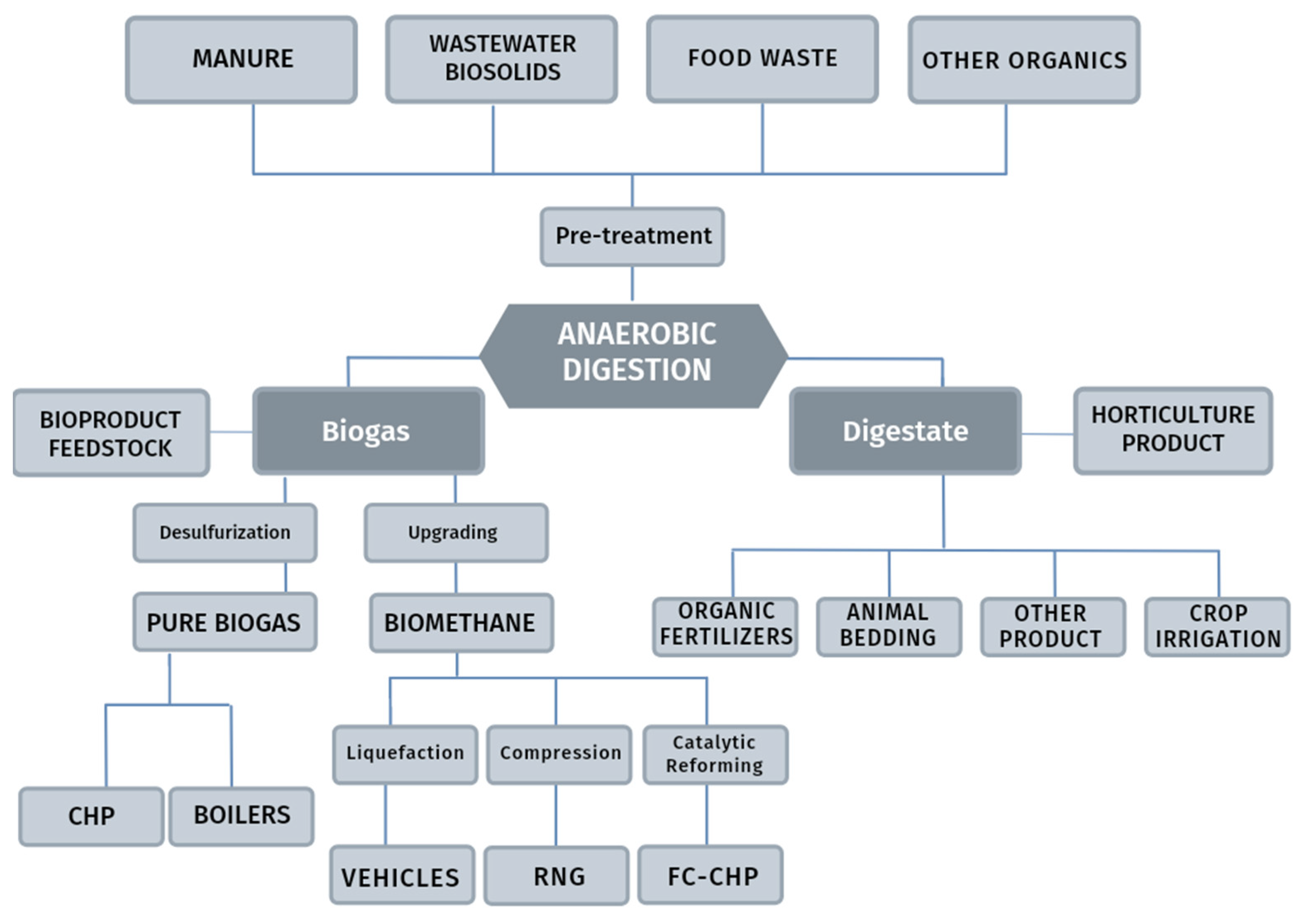
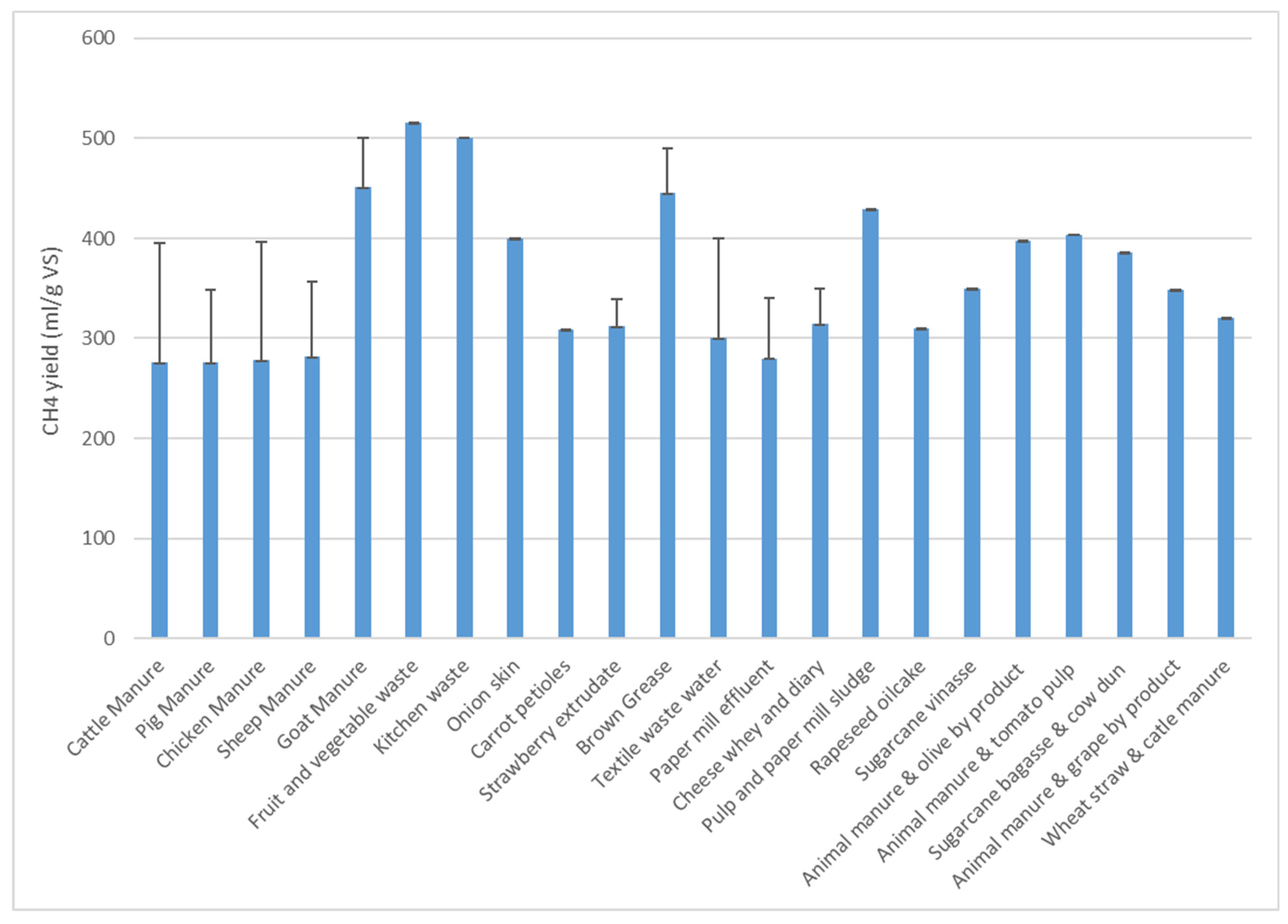

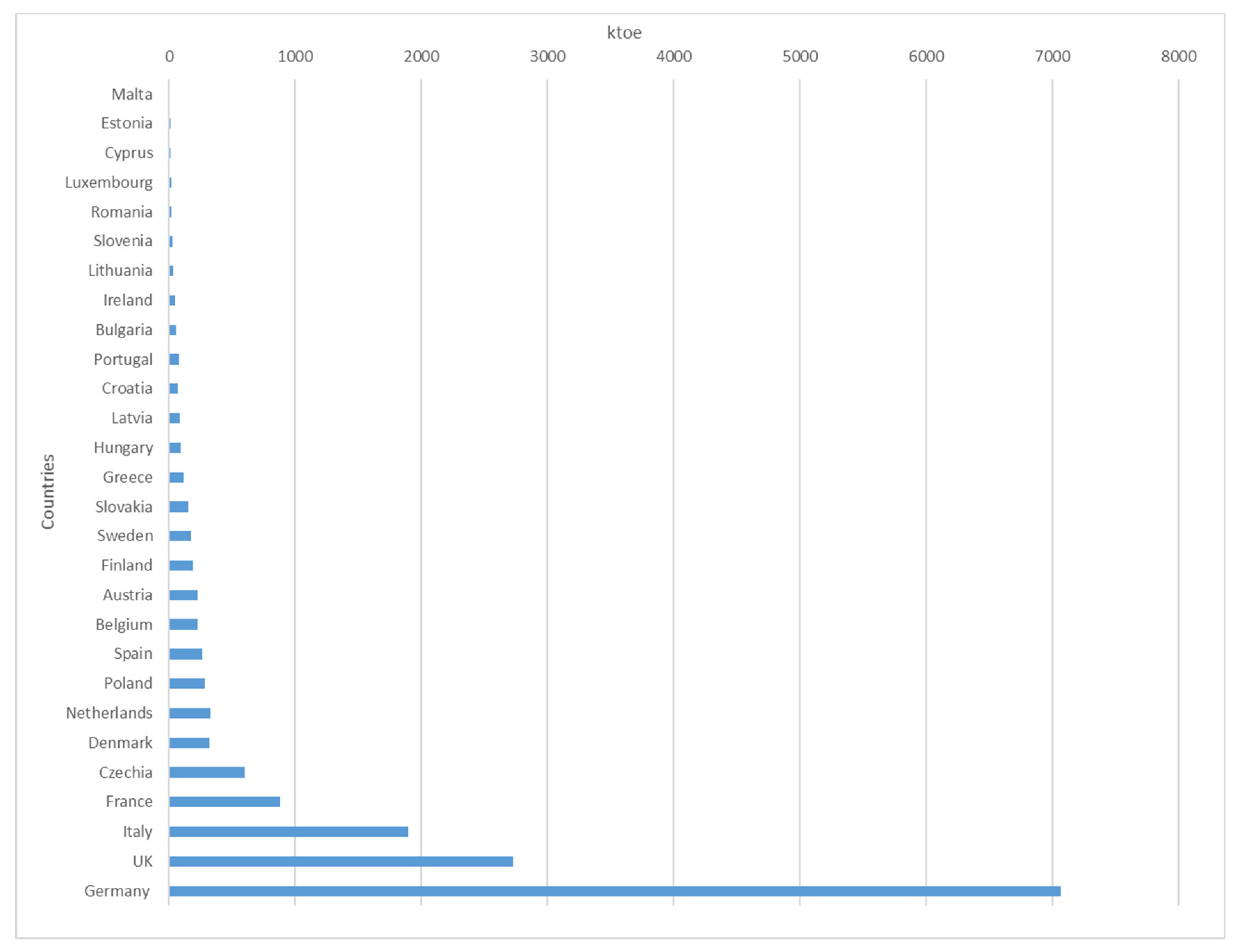
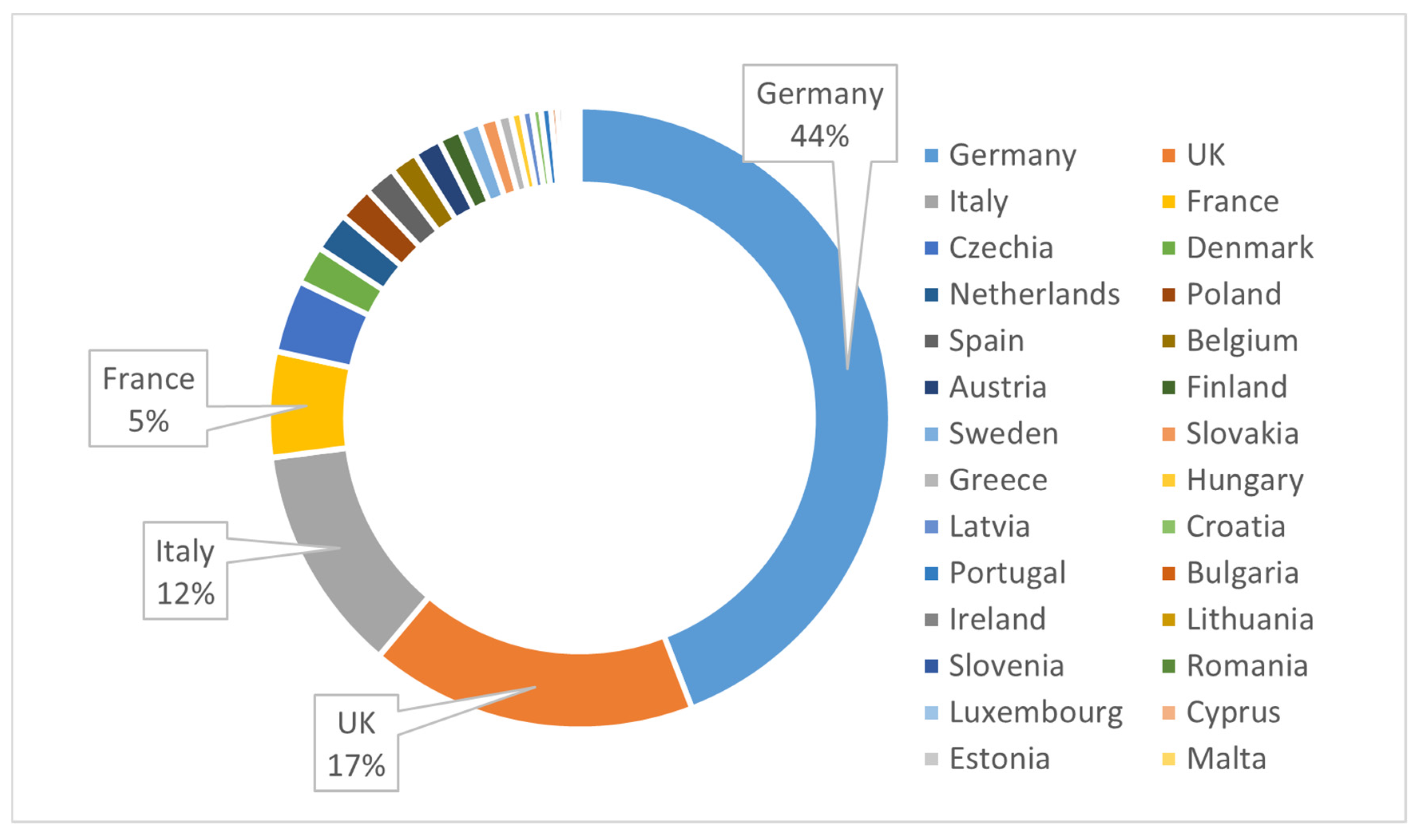
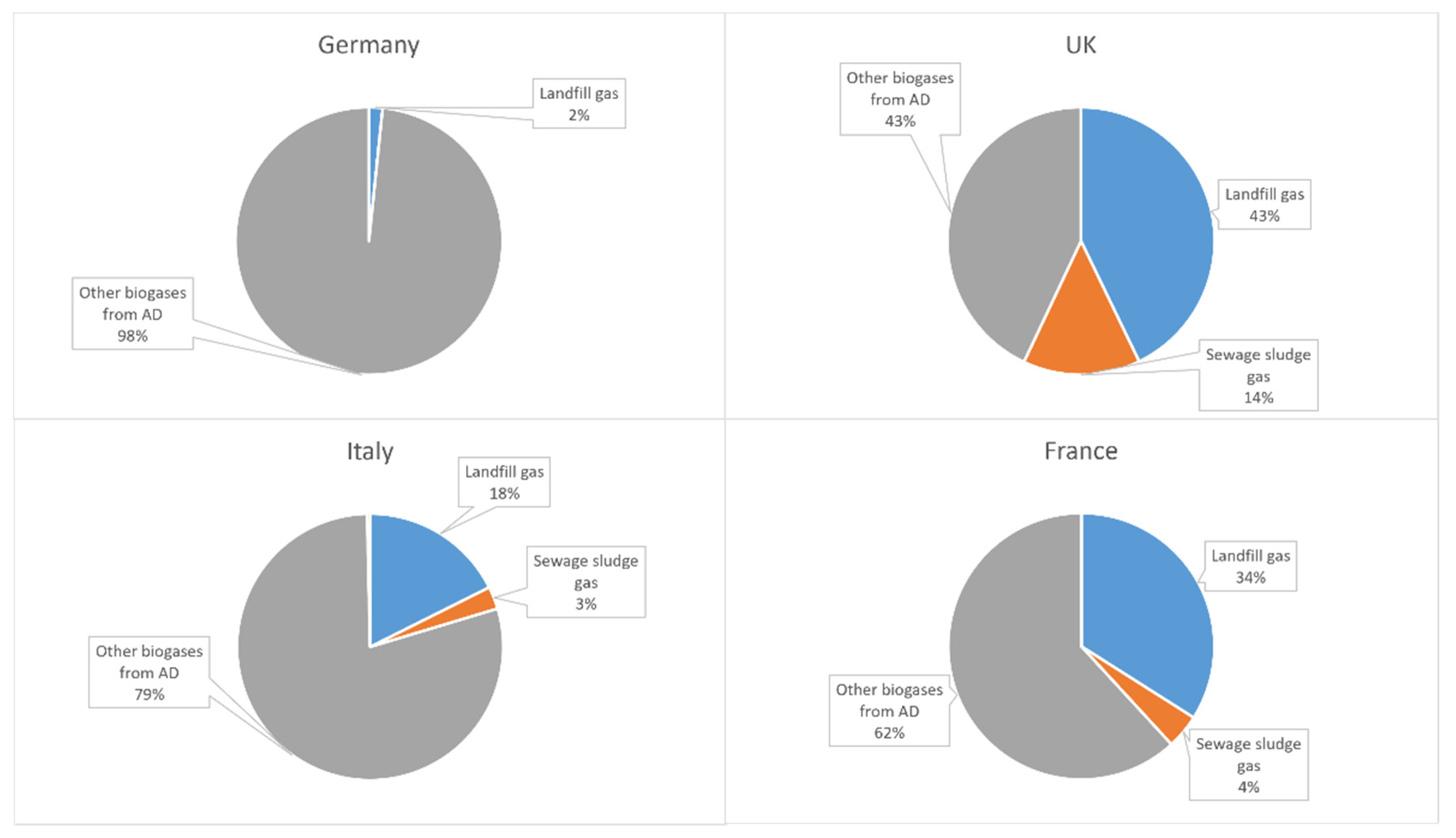
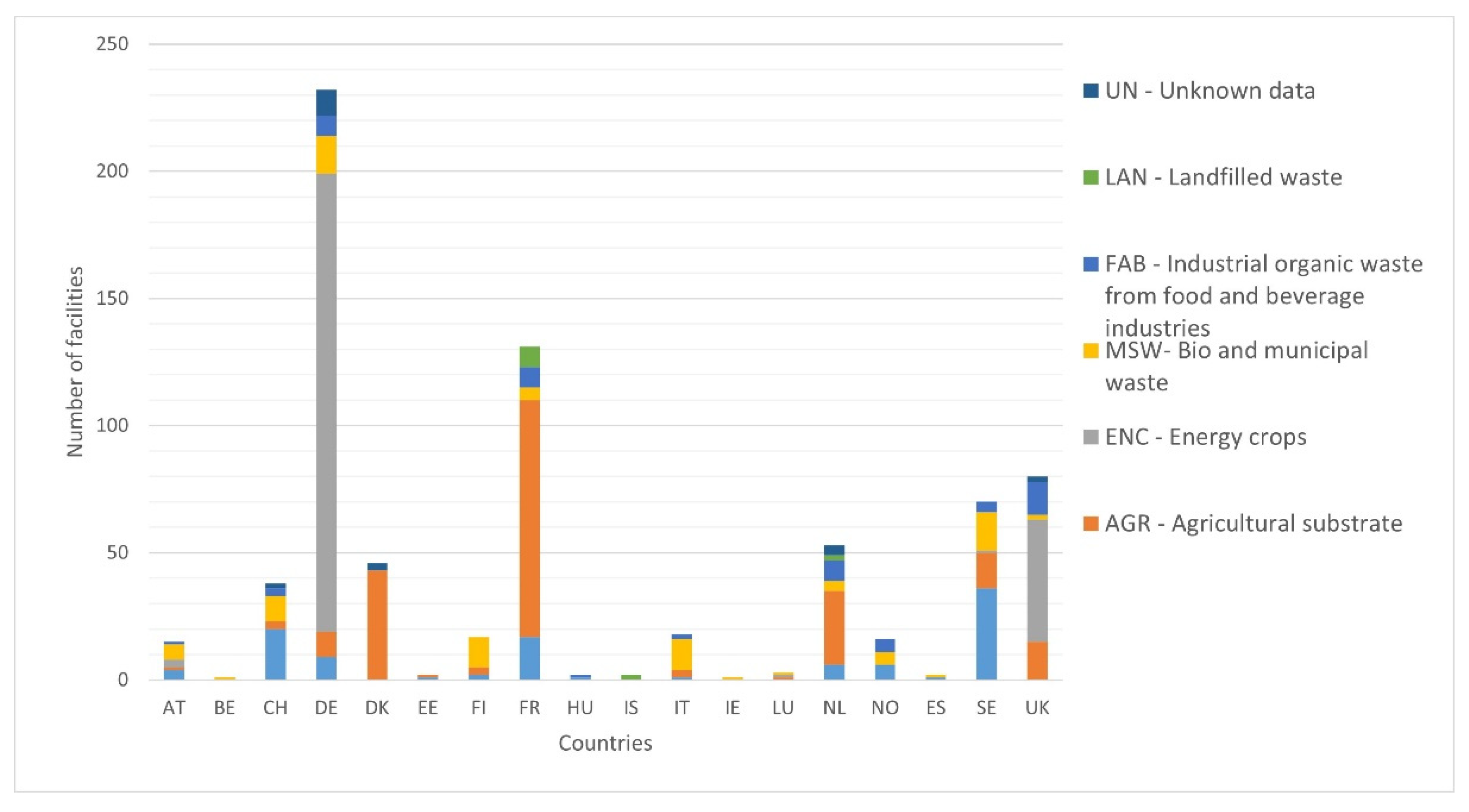
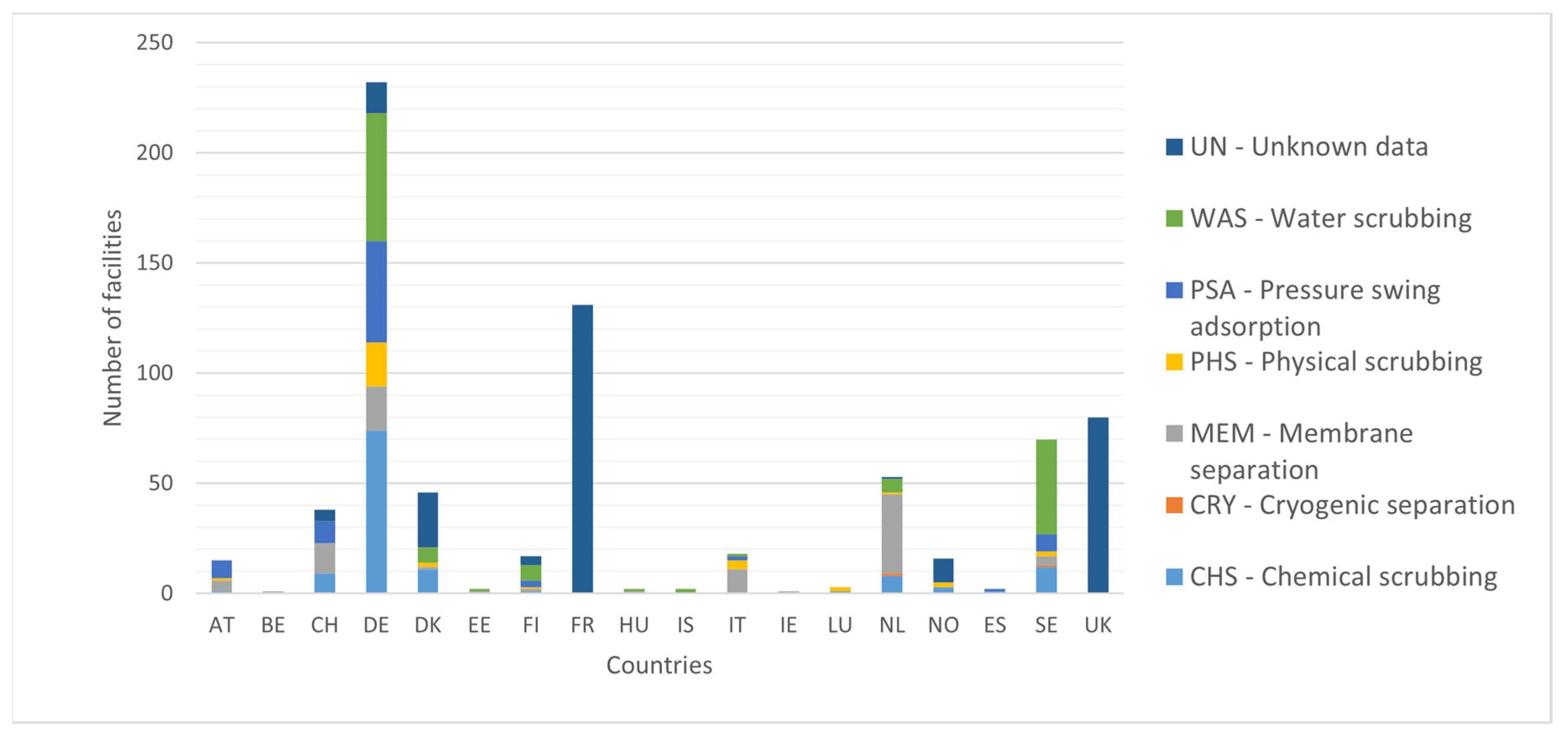
| Compound | Formula | Volume Share (%) | |||
|---|---|---|---|---|---|
| Biogas | Natural Gas | ||||
| Korbag et al. [14] | Persson et al. [39] | Moya et al. [40] | IEA Bioenergy [41] | ||
| Methane | CH4 | 50–75 | 53–70 | 55–70 | 83–98 |
| Carbon dioxide | CO2 | 25–50 | 30–47 | 30–45 | 0–1.4 |
| Water | H2O | 5–10 | / | /−5 | |
| Oxygen | O2 | <2 | 0 | 0–3 | |
| Nitrogen | N2 | <10 | 0.2 | <15 | 0.6–2.7 |
| Ammonia | NH3 | <1 | <1 (<100 ppm) | <1 (0–100 ppm) | / |
| Hydrogen | H2 | <1 | 0 | / | / |
| Hydrogen sulphide | H2S | <3 | <1 (0–10,000 ppm) | <1 (0–10,000 ppm) | / |
| Ethane | <11% | ||||
| Propane | <3% | ||||
| AD Process Stage | Chemical Reactions | |
|---|---|---|
| Hydrolysis | (C6H10O5)n + n H2O → n C6H12O6 + n H2 | (1) |
| Acidogenesis | C6H12O6 ↔ 2 CH3CH2OH + 2 CO2 | (2) |
| C6H12O6 + 2 H2 ↔ 2 CH3CH2COOH + 2 H2O | (3) | |
| C6H12O6 → 3 CH3COOH | (4) | |
| Acetogenesis | CH3CH2COO− + 3 H2O ↔ CH3COO− + H+HCO3− + 3 H2 | (5) |
| C6H12O6 + 2 H2O ↔ 2 CH3COOH + 2 CO2 + 4 H2 | (6) | |
| CH3CH2OH + 2 H2O ↔ CH3COO− + 3 H2 + H+ | (7) | |
| Methanogenesis | CH3COOH → CH4 + CO2 | (8) |
| CO2 + 4 H2 → CH4 + 2 H2O | (9) | |
| 2 CH3CH2OH + CO2 → CH4 + 2 CH3COOH. | (10) | |
| Pretreatment Type | Method | Mode of Action |
|---|---|---|
| Physical | Milling Extrusion Cavitation Microwave Irradiation | Biomass is altered by cells breaking when physical force is used. |
| Physico-chemical | Liquid Hot Water Steam Explosion Ammonia Fiber Expansion CO2 Explosion | A combination of mechanical forces and chemical effects applied to biomass. |
| Chemical | Alkaline Hydrolysis Acid Hydrolysis Ionic Liquids Organosolv Wet Oxidation | Use of organic or inorganic compounds to disrupt the structural recalcitrance of lignocellulosic biomass. |
| Biological | Enzyme-producing fungi are used to alter biomass. |
| Method | Working Principle | |
|---|---|---|
| Absorption | Water scrubbing | Different solubilities of H2S and CO2. |
| Adsorption | In situ chemical precipitation (iron salts) | Chemicals used dissolves sulphides into either insoluble metallic sulphide compounds or elemental S. |
| Metal oxides Al, Fe, Mn, Co, Cu, Zn oxides) | H2S adsorbs metal oxides by the sulphur binding as metal sulphide; Efficient in mercaptans removal. | |
| Activated carbon (impregnated, virgine) | Catalyze H2S oxidation into elemental S. | |
| Biological | Microorganisams are used to convert H2S into S. | |
| Membranes | Selective selectivity characteristics of CH4 and H2S. | |
| In-situ microaeration | Adding O2 or air directly in digester. | |
| Method | Working Principle | |
|---|---|---|
| Absorption | Water scrubbing | Different solubilities of H2S and CO2. |
| Physical scrubbing | ||
| Chemical scrubbing (amines) | Chemical reactions of amine mixture with CO2. | |
| Adsorption | Pressure swing adsorption (PSA) Vacuum swing adsorption (VSA) | Pressure changes in different process stages. VSA adsorption occur near atmospheric pressure. |
| Temperature swing adsorption | Temperature changes in different process stages. | |
| Membranes (gas–gas separation, gas-liquid separation) | Selective selectivity characteristics of CH4 and H2S. | |
| Cryogenic separation | Different boiling temperatures of CO2 and CH4. | |
| Biogas Usage | Topics Elaborated in Recent Publications on Biogas Related Issues |
|---|---|
| Production of heat or steam | Advantages of biogas cook stoves in wood scarcity and agricultural regions [106]; Life cycle energy and cost analysis of small-scale biogas facilities in rural regions [107]; Design features, construction material, feedstock, and operation parameters that made anaerobic digestion in small digesters [108]; Optimisation of techno-economic design of biogas digester [109]. |
| Electricity generation or Combined Heat and Power (CHP) | Modelling and simulations of demand-orientated biogas-based power production [110]; Modelling of rural multi-energy complementary system with biogas cogeneration and electric vehicle considering carbon emission and satisfaction [111]; Load response of biogas CHP systems in a power grid [112]; Comparative analysis of different CHP systems using biogas for the cassava starch plants [113]. |
| Vehicle fuel | Perspectives of biogas conversion into Bio-CNG for automobile fuel, Bangladesh case study [114]; Comparative analyses of the impact of biogas and biogas with hydrogen fuels on vehicle emissions and performance [115]; Sugarcane bagasse and straw as a biofuel to propel light vehicles [116]; System perspective on biogas use for transport and electricity production. Energies [117]. |
| Fuel cell | Potential and constraints of solid Oxide Fuel Cells fuelled with biogas [33]; Biogas production and usage with legislations framework across the globe [15]; Biogas fed-fuel cell-based electricity generation: a life cycle assessment approach [118]. |
Publisher’s Note: MDPI stays neutral with regard to jurisdictional claims in published maps and institutional affiliations. |
© 2022 by the authors. Licensee MDPI, Basel, Switzerland. This article is an open access article distributed under the terms and conditions of the Creative Commons Attribution (CC BY) license (https://creativecommons.org/licenses/by/4.0/).
Share and Cite
Pavičić, J.; Novak Mavar, K.; Brkić, V.; Simon, K. Biogas and Biomethane Production and Usage: Technology Development, Advantages and Challenges in Europe. Energies 2022, 15, 2940. https://doi.org/10.3390/en15082940
Pavičić J, Novak Mavar K, Brkić V, Simon K. Biogas and Biomethane Production and Usage: Technology Development, Advantages and Challenges in Europe. Energies. 2022; 15(8):2940. https://doi.org/10.3390/en15082940
Chicago/Turabian StylePavičić, Josipa, Karolina Novak Mavar, Vladislav Brkić, and Katarina Simon. 2022. "Biogas and Biomethane Production and Usage: Technology Development, Advantages and Challenges in Europe" Energies 15, no. 8: 2940. https://doi.org/10.3390/en15082940
APA StylePavičić, J., Novak Mavar, K., Brkić, V., & Simon, K. (2022). Biogas and Biomethane Production and Usage: Technology Development, Advantages and Challenges in Europe. Energies, 15(8), 2940. https://doi.org/10.3390/en15082940







